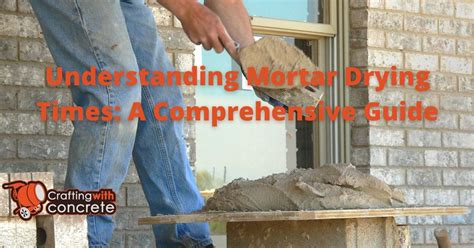Mortar Drying Time: Project Delays Explained
Mortar, that ubiquitous building material, plays a crucial role in countless construction projects. However, its drying time is often underestimated, leading to significant project delays and costly rework. Understanding the factors that influence mortar drying time is essential for successful project management and avoiding unnecessary setbacks. This article delves into the intricacies of mortar drying, exploring the variables involved and offering practical solutions for managing this critical aspect of construction.
What Determines Mortar Drying Time?
Several factors interplay to determine how long mortar takes to dry completely. Ignoring these can lead to significant delays and compromised structural integrity.
1. Type of Mortar: Different mortar types have varying drying times. For example, Portland cement-based mortars generally take longer to dry than lime-based mortars. The specific mix design, including the cement type and admixtures, significantly impacts the drying process.
2. Environmental Conditions: This is perhaps the most influential factor. High temperatures and low humidity accelerate drying, while cold, damp conditions significantly prolong it. Wind speed also plays a role, with increased wind leading to faster surface drying but potentially uneven drying throughout the mortar.
3. Mortar Thickness: Thicker mortar layers naturally take longer to dry than thinner ones. This is due to the longer distance moisture needs to travel to evaporate. Proper application techniques, ensuring even thickness, are crucial for consistent drying.
4. Substrate Porosity: The material the mortar is applied to (the substrate) influences drying time. Porous substrates, like some types of brick, absorb moisture from the mortar, accelerating the drying process. Non-porous substrates, such as concrete blocks, may retain more moisture, slowing down drying.
5. Ambient Air Movement: Good air circulation around the mortar helps remove moisture, speeding up the drying process. Stagnant air can trap moisture, leading to delays and potential problems like efflorescence (salt deposits on the surface).
6. Curing Process: Proper curing is not just about drying; it's about allowing the mortar to develop its full strength. This often involves keeping the mortar moist for a specific period, counterintuitively slowing down surface drying but ultimately leading to stronger, more durable joints.
How Long Does Mortar Typically Take to Dry?
There's no single answer to this question. The general rule of thumb is to allow several days to a week for initial drying, depending on the factors mentioned above. However, full curing, where the mortar reaches its design strength, can take several weeks or even months, especially in colder climates.
What are the signs of fully cured mortar?
Fully cured mortar will be hard to the touch, showing no signs of moisture, and it will have achieved its designated compressive strength.
H2: What Happens if Mortar Doesn't Dry Properly?
Improper drying can lead to several issues, including:
- Reduced Strength: Mortar that dries too quickly may not achieve its full compressive strength, leading to weak joints and potential structural failure.
- Cracking: Uneven drying can cause cracks to form in the mortar, compromising its aesthetic appeal and structural integrity.
- Efflorescence: Moisture trapped within the mortar can cause salts to migrate to the surface, resulting in unsightly white deposits.
- Frost Damage: If mortar freezes before it's fully cured, it can be severely damaged, leading to cracking and deterioration.
H2: How to Manage Mortar Drying Time Effectively?
Effective project management requires proactively addressing potential delays related to mortar drying. Here's how:
- Choose the right mortar: Select a mortar type appropriate for the application and environmental conditions.
- Monitor weather conditions: Be aware of temperature and humidity forecasts and adjust the work schedule accordingly.
- Control the application: Apply mortar evenly and to the correct thickness.
- Ensure proper curing: Follow the manufacturer's recommendations for curing the mortar.
- Provide adequate ventilation: Ensure good air circulation around the mortared areas.
- Use protective coverings: In extreme conditions, consider using protective coverings to shield the mortar from harsh weather.
H2: What are the common causes of mortar drying delays?
Common causes include unexpectedly inclement weather, using the incorrect mortar type for the conditions, applying mortar too thickly, and inadequate curing practices.
H2: How can I speed up the mortar drying process?
While fully controlling the drying process is difficult, you can influence it by improving ventilation, using a faster-drying mortar type (if appropriate), and applying thinner layers. However, prioritizing proper curing over speed is crucial for long-term structural integrity.
By understanding the factors that influence mortar drying time and implementing appropriate management strategies, construction professionals can minimize delays, improve project outcomes, and build structures that stand the test of time. Remember, patience and a thorough understanding of the material are key to successful masonry work.

